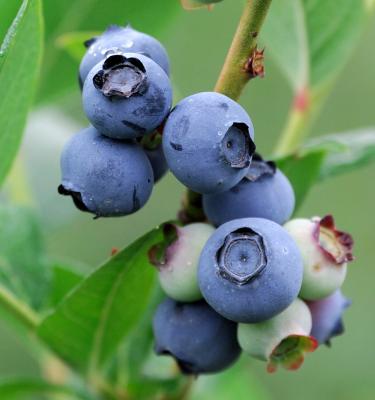

How to grow blueberries in New Zealand
Eaten fresh, baked in muffins or as the star attraction in jams or desserts, blueberries are always delicious. They are also rich in vitamin C and antioxidants, so it is no wonder they have been hailed as a ‘superfood’. Blueberries are easy to grow at home in your garden.
When to grow blueberries
- Plant: August to November & February to May
- Harvest: December to April
Blueberry varieties to grow in New Zealand
Blueberries are native to North America and Canada, there are three main varieties grown in New Zealand. Northern Highbush, Southern Highbush, and Rabbiteye.
Note, these plants are native to the Northern Hemisphere, so the northern and southern references are opposite to New Zealand.
- Blueberry Northern Highbush - require high winter chilling, so best suited to cooler southern regions in NZ. Hardy plants with large fruit. These varieties flower in mid spring and produce berries from December to February. Cross-pollinate with another Northern Highbush variety. Deciduous. Varieties: 'Bluecrop’, ‘Dixi’, ‘Duke’.
- Blueberry Southern Highbush – suited to warmer regions of NZ as they have a low winter chill requirement. Flower mid spring and produce large fruit from November to February. Cross- pollinate with another Highbush variety. Deciduous. Varieties: ‘Marimba’, ‘Misty’, ‘Petite Blue’.
- Rabbiteye – suitable for all regions in New Zealand as they require less winter chilling, in frost prone regions protect from frost when flowering. Flower in early spring and fruit from January through to April. Less fussy on soil type and more drought tolerant than Highbush varieties. Cross-pollinate with another Rabbiteye variety. Evergreen. Varieties: ‘Climax’, ‘Delite’, ‘Tifblue’, ‘Blue Dawn’, ‘Blue Magic’.
Grow your blueberry plants
Blueberries belong to the same family as azaleas, rhododendrons and Ericas, and so require acid soils with a pH of 5.5 or lower, to grow well. Before planting dig in generous amounts of Scotts Sheep Pellets, compost, leaf mould, composted pine needles, or any other organic matter to improve the soil.
Step 1
Plant your blueberries in late winter, early spring. Choose a sunny sheltered position with free draining soil. Good drainage is essential.
If planting into clay soils dig an extra big hole and fill with Scotts Osmocote Rose, Gardenia, Azalea & Camellia Mix, and compost or plant into raised garden beds.
Step 2
Mix into the soil generous amounts of Scotts Osmocote Compost Premium Soil Improver to improve the soil and retain soil moisture. This contains a 3 month controlled release fertiliser for constant feeding.
Step 3
Soak plants in a bucket of water before planting, remove once the bubbles stop coming to the surface. Drain well before planting.
Step 4
Remove the plant from its pot and gently loosen the root ball. Space plants 1.5 metres apart.
Step 5
Dig a hole approximately twice the diameter and depth of the root ball. Place the plant into the planting hole and backfill, gently firming around the root ball as you go. Plant to the same depth as it was in its original pot.
Step 6
Blueberries are shallow rooting, once planted add Scotts Pea Straw Mulch around the plants at least 50mm thick to help conserve soil moisture and to protect the roots in summer.
Tips
It is essential to give blueberries the conditions they enjoy growing in. They grow well in acid soils with a pH of 5.5 or lower. A simple soil test kit can be used to test soil pH. If needing to lower the pH use peat moss or apply flowers of sulphur.
Most varieties are self-fertile not requiring a pollinator, but you will get more fruit by planting a combination of varieties of the same type for cross-pollination. Bumble bees and bees are the main pollinators.
Growing blueberries in pots and containers
If soil conditions are not suitable for growing blueberries in the garden, they grow equally as well in pots and containers.
Choose compact varieties such as Blueberry ‘Muffin’ that grows 60cm high. Most varieties can be kept trimmed to around 1 metre, growth is naturally restricted when growing in containers.
Step 1
Choose a pot that is at least 30cm in diameter and up to 50cm deep. Ensure the pot has drainage holes and use a quality free-draining mix suitable for acid-loving plants such as Scotts Osmocote Rose, Gardenia, Azalea & Camellia potting mix.
Step 2
Before planting, soak plants in a bucket of water until the bubbles stop rising and allow to drain.
Step 3
Partly fill the container with Scotts Osmocote Rose, Gardenia, Azalea & Camellia potting mix. When planting, allow for 3cm of space from the potting mix surface to the top lip of the pot, this allows for watering.
Step 4
Remove the plant from its original pot and gently loosen the root ball. Place the plant into the centre of the partly filled pot. Fill around the plant, gently firming as you go. Plant to the same depth as the original pot.
Step 5
Tap the pot to settle the mix and water well. Maintain regular watering throughout the growing season.
Step 6
Feed weekly with Scotts Performance Naturals Citrus & Fruit Liquid fertiliser during the growing season.
Blueberry plant care
- Feed in late winter, early spring and again in late summer-early autumn with Scotts Osmocote Rose, Gardenia, Azalea & Camellia fertiliser.
- Remove fruit that sets in the first season. If left to fruit the plants energies will go into the fruit rather than establishing a good root system to support the plant in years to come.
- Protect from birds using bird netting or bird scarer tape.
Harvesting your blueberries
Blueberries start to ripen from mid-summer onwards. The fruit turns a ‘dusty’ blue colour when ripe and comes away easily from the stalk. Berries won’t all ripen at the same time, so pick berries as they ripen.
Blueberry tree pruning
- Fruit forms on one-year old wood i.e. so second seasons growth.
- Once established, prune in summer.
- Remove dead or diseased wood, weak spindly criss-crossing branches.
- Remove older wood to regenerate new growth from the base of the plant.
- Shorten any long water shoots so new fruit buds grow in the centre of the bush.



